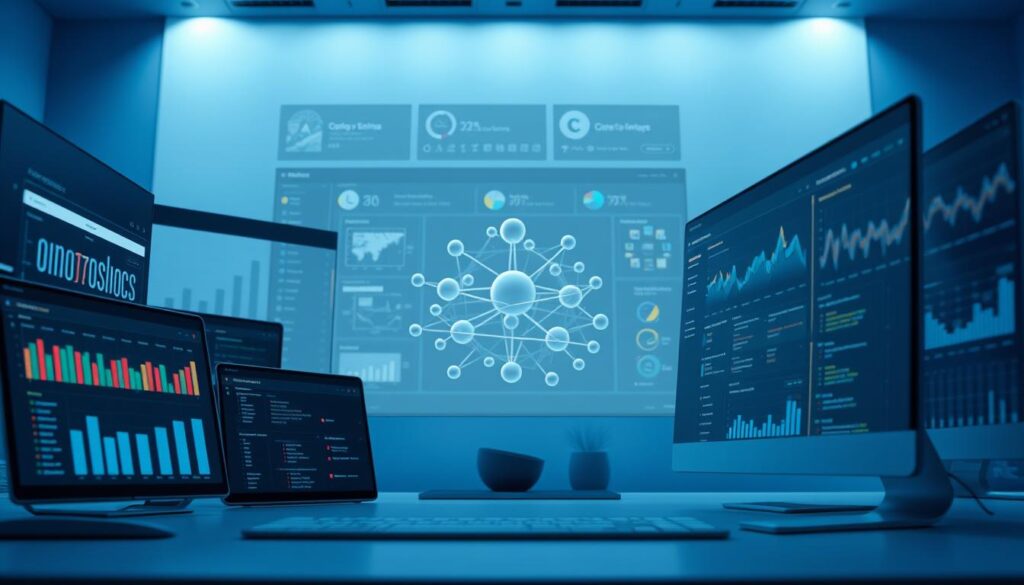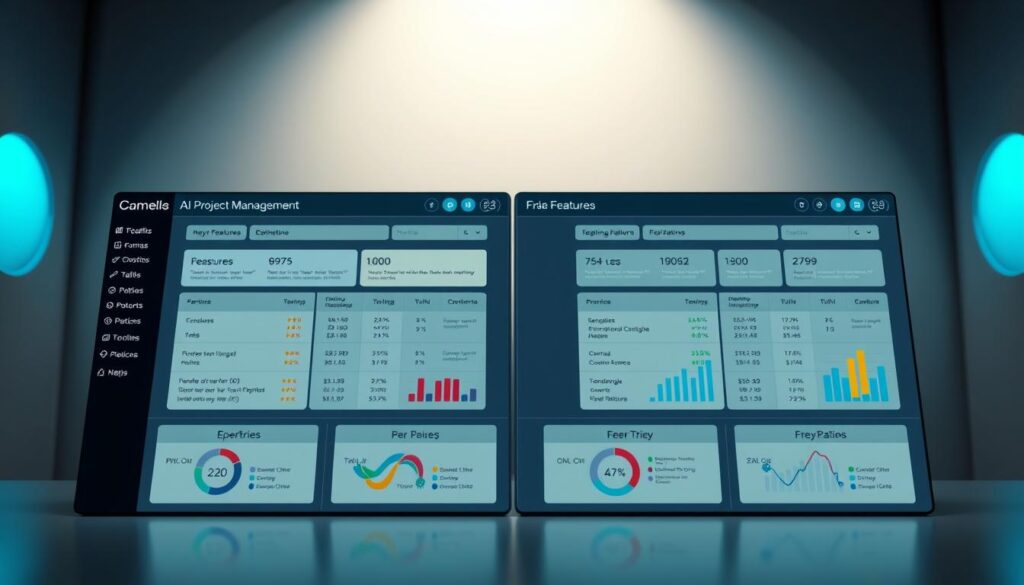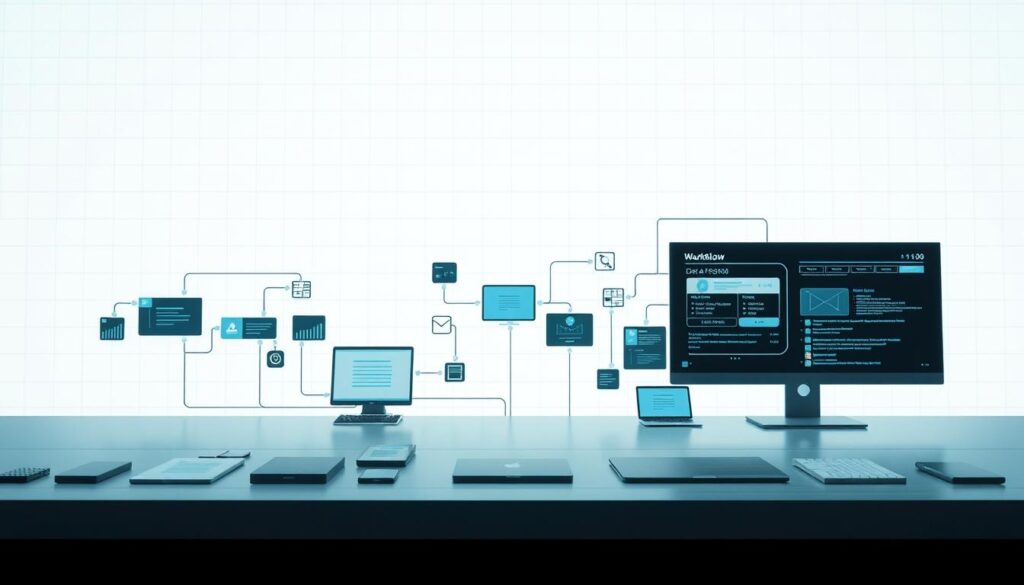Are you tired of juggling endless tasks and struggling to keep your team on track? Imagine a tool that not only simplifies your workflow but also enhances your team’s productivity. How do you choose the right solution for your needs?
In today’s fast-paced business environment, staying organized is crucial. Many teams face challenges like missed deadlines, poor communication, and inefficient resource allocation. This is where intelligent solutions come into play. They automate repetitive tasks, provide real-time insights, and help you make data-driven decisions.
From predictive scheduling to intelligent risk management, these platforms are transforming how teams operate. For instance, Forecast’s AI can improve utilization rates by 21% and increase billable hours by up to 43%1. Similarly, Salesforce AI has enabled companies to reduce admin time by 50%, allowing more focus on growth opportunities2.
But with so many options available, how do you decide? This article will guide you through the features, benefits, and real-world applications of leading tools. Whether you’re managing a small team or a large enterprise, you’ll find actionable insights to streamline your operations.
Key Takeaways
- Intelligent tools automate repetitive tasks, saving time and reducing errors.
- Predictive analytics improve resource allocation and project timelines.
- Real-time dashboards provide visibility into risks and progress.
- Flexible pricing makes these solutions accessible for businesses of all sizes.
- Data-driven insights help teams make informed decisions quickly.
Introduction to AI-Driven Project Management

What if there was a smarter way to manage your team’s efficiency and productivity? Modern solutions are transforming how businesses operate by introducing advanced automation and real-time insights. These tools are designed to simplify complex workflows and enhance decision-making processes.
At its core, AI-driven project management leverages technology to automate repetitive tasks, reducing manual errors and saving time. For example, generative tools can create first drafts of documentation in minutes, cutting down hours of work3. This allows teams to focus on strategic goals rather than administrative burdens.
Real-time insights are another game-changer. These tools analyze historical data to predict potential roadblocks and suggest realistic timelines3. This shift from reactive to strategic planning empowers managers to make informed decisions quickly.
Businesses of all sizes can benefit from these advancements. Whether you’re a small startup or a large enterprise, implementing these solutions can lead to significant cost savings and risk mitigation. For instance, organizations using these methods complete 30% more projects on time and 25% within budget3.
The evolution from traditional methods to AI-supported approaches marks a new era in project management. These tools not only optimize resource allocation but also foster innovation and growth. As we explore further, you’ll discover how these features can transform your workflows and drive success.
The Evolution of Project Management with AI

The journey from manual planning to advanced systems has transformed workflows. In the past, teams relied on spreadsheets and basic tools to manage tasks. These methods were time-consuming and prone to errors. Today, intelligent platforms have revolutionized how teams operate.
Historically, task handling involved manual scheduling and resource allocation. This often led to inefficiencies and missed deadlines. With the introduction of tech-driven solutions, repetitive tasks are now automated, saving time and reducing errors4.
One major milestone was the shift from spreadsheets to integrated platforms. These systems provide real-time insights and predictive analytics. For example, they can reduce manual scheduling by up to 60%4. This allows teams to focus on strategic goals rather than administrative tasks.
Modern systems also enhance data gathering and analysis. They use historical data to predict potential roadblocks and suggest realistic timelines5. This shift from reactive to proactive planning has improved outcomes significantly.
Another key advancement is the scalability of these platforms. Whether you’re managing a small team or a large enterprise, these solutions adapt to your needs. They ensure no team member is overburdened, reducing burnout and improving productivity4.
The impact of digital transformation on task handling cannot be overstated. Teams now complete more projects on time and within budget5. This evolution marks a new era in how we approach workflows, fostering innovation and growth.
Benefits of AI in Project Management

What if your team could achieve more with less effort and fewer errors? Modern tools are designed to simplify your workflow and enhance productivity. By automating repetitive tasks, these solutions save time and reduce human errors by up to 40%6. This allows your team to focus on strategic goals rather than administrative burdens.
Streamlined Automation and Efficiency
One of the standout features of these tools is their ability to handle routine tasks. For example, scheduling efficiency can improve by 50% as systems adapt to real-time changes in team availability6. This ensures no one is overburdened, reducing burnout and improving overall productivity.
These platforms also standardize processes, minimizing manual interventions. By optimizing resource allocation, they can increase efficiency by 25%6. This means your team can handle more tasks without compromising quality.
Real-Time Insights for Informed Decisions
Another key benefit is the ability to provide actionable insights in real time. Predictive analytics can identify potential delays in 70% of cases, allowing you to take preemptive action6. This shift from reactive to proactive planning ensures smoother workflows.
For managers, this means better oversight of multiple projects. Tools like Forecast integrate with platforms like Jira or Trello, automating task assignments and triggering alerts for bottlenecks7. This level of visibility helps you make informed decisions quickly.
“The combination of automation and real-time insights has transformed how we manage projects, leading to a 20% increase in success rates.”
By leveraging these features, you can achieve a more efficient and error-free workflow. The result? A team that works smarter, not harder, and delivers consistent results.
Key Features to Look For in AI Tools

What features should you prioritize to make your workflow seamless and efficient? The right tool can address diverse needs, from scheduling to team communication. Here’s what to consider when choosing a solution.
An intuitive interface is crucial. It ensures your team can adopt the tool quickly without extensive training. Tools like Asana and Forecast excel in this area, offering user-friendly dashboards that simplify task handling8.
Comprehensive document management is another must-have. It allows you to store, organize, and share files effortlessly. This feature reduces time spent searching for information and keeps everyone on the same page.
Real-time scheduling and automated reporting are equally important. These features help you track progress and adjust timelines dynamically. For instance, Forecast’s AI improves utilization rates by 21%, ensuring resources are allocated efficiently1.
Predictive analytics and data consolidation are game-changers. They provide insights into potential roadblocks and help you make informed decisions. Tools like Asana integrate with over 200 applications, enhancing cross-team collaboration8.
When evaluating a tool, consider its integration capabilities. Seamless connections with platforms like Slack and Google Drive streamline workflows and reduce manual effort. This ensures your project manager can focus on strategic goals rather than administrative tasks.
“The right features can transform how you manage tasks, ensuring efficiency and clarity across your team.”
By prioritizing these features, you’ll find a tool that meets your needs and enhances productivity. Whether it’s Asana’s scalability or Forecast’s predictive capabilities, the right choice can make all the difference.
How AI Enhances Team Collaboration and Communication

Have you ever wondered how your team could communicate more effectively? Modern tools are designed to bring everyone together, eliminating gaps and streamlining workflows. By integrating team efforts into one platform, these solutions foster better collaboration and efficiency.
One key feature is intelligent scheduling. It ensures meetings and deadlines are coordinated seamlessly. For example, tools like Asana and Trello automate task assignments and send reminders, reducing the need for constant follow-ups9. This keeps everyone on track without overwhelming them.
Automated reminders and real-time updates play a crucial role in improving responsiveness. When changes occur, team members are notified instantly, allowing them to adapt quickly. This reduces delays and ensures smoother workflows10.
Centralized task and calendar management is another game-changer. It provides a unified view of all activities, making it easier to prioritize and allocate resources. This approach eliminates confusion and ensures everyone is aligned with the same goals11.
Seamless integration with third-party apps like Slack and Google Drive further enhances communication. It creates a cohesive ecosystem where information flows effortlessly, reducing bottlenecks and improving productivity9.
“The integration of these tools has transformed how we collaborate, leading to a 20% increase in team efficiency.”
By leveraging these features, you can create a more connected and responsive team. The result? Improved satisfaction, better outcomes, and a streamlined workflow that works for everyone.
Leveraging AI for Risk Mitigation and Cost Savings

How can you minimize risks and maximize savings in your operations? Advanced tools analyze historical data to predict potential pitfalls, allowing you to address issues before they escalate12. This proactive approach ensures smoother workflows and better outcomes.
One key feature is the ability to identify factors that historically lead to delays or cost overruns. For example, missed testing milestones often correlate with post-launch defects12. By flagging these patterns early, you can take corrective action and maintain quality.
Resource optimization is another critical aspect. These tools assess skill levels against task complexity, raising alerts for mismatches or onboarding delays12. This ensures your team is always ready to tackle challenges efficiently.
Predictive algorithms also help foresee bottlenecks before they impact timelines. By monitoring scalability and performance metrics, you can detect potential issues early12. This solution reduces downtime and keeps your operations on track.
Financial savings are a direct result of these features. Companies waste approximately $122 million for every $1 billion spent due to poor planning13. By leveraging these tools, you can significantly reduce such losses and improve your bottom line.
“The integration of predictive analytics has transformed how we manage risks, leading to a 20% reduction in project delays.”
These tools also enhance content management by flagging gaps in documentation or testing coverage12. This ensures all aspects of your operations are well-documented and compliant.
Overall, the combination of risk prediction and resource optimization leads to better product quality and operational efficiency. By adopting these solutions, you can achieve a more streamlined and cost-effective workflow.
Optimizing Workflows with AI-Powered Automation

Imagine a system that handles repetitive tasks for you, freeing up your time for strategic decisions. This is the way modern tools are transforming workflows. By automating routine processes, they reduce manual effort and improve efficiency14.
One of the standout features is automated report generation. Instead of spending hours compiling data, these tools create detailed updates in minutes. This allows you to monitor progress in real time and make informed decisions quickly14.
Integration with marketing platforms is another game-changer. Tools like Zapier and Make connect seamlessly with systems like Google Ads and HubSpot. This ensures data flows smoothly across departments, enhancing collaboration15.
For example, UiPath automates complex workflows, reducing project completion times by up to 30%14. Similarly, Microsoft Power Automate streamlines administrative tasks, saving an average of 10 hours per week14.
By combining automation with established processes, teams experience improved operational flow. This reduces workload and minimizes human error, leading to better outcomes14.
“Automation has transformed our workflow, allowing us to focus on what truly matters—innovation and growth.”
These tools also enhance marketing efforts by automating campaign tracking and analysis. This ensures your strategies are data-driven and effective15.
In summary, adopting these solutions is the way to optimize your workflow. From automated reports to seamless integrations, they empower your team to achieve more with less effort.
AI Project Management Software: Which One is Right for You?

Choosing the right solution for your team can feel overwhelming with so many options available. The key is to focus on your specific needs, integration capabilities, and team size. By evaluating these factors, you can find a management tool that aligns perfectly with your goals.
Start by comparing high-ranking tools based on their functionalities and usability. For example, some platforms excel in predictive analytics, reducing project delays by up to 30%16. Others focus on automation, cutting manual task management time by 30%6. These features can significantly enhance your workflow.
Integration capacities are another critical factor. A management software that seamlessly connects with tools like Slack or Google Drive ensures smoother collaboration. This eliminates bottlenecks and keeps your team aligned3.
Team size also plays a role in your decision. Smaller teams may benefit from simpler interfaces, while larger organizations might need advanced features like resource allocation and real-time insights. For instance, AI-driven tools can increase resource efficiency by 40%6, making them ideal for complex projects.
“The right tool not only simplifies workflows but also boosts productivity and morale.”
When evaluating a project management tool, consider its core features and user reviews. Platforms like Asana and Forecast are highly rated for their intuitive interfaces and predictive capabilities3. These insights can help you make an informed choice.
Ultimately, the best solution is one that matches your organizational needs. By focusing on functionality, integration, and scalability, you can find a tool that drives success. For more guidance on selecting the right AI tools, explore our detailed resources.
Overview of Top AI Tools for Project and Resource Management

Streamlining your workflow starts with the right tools. With so many options available, it’s essential to choose platforms that align with your team’s needs. Let’s explore three standout solutions: Forecast, Taskade, and Timely. Each offers unique features to enhance efficiency and collaboration.
Forecast: Best for Predictive Analytics
Forecast excels in predictive analytics, helping teams anticipate delays and optimize resource allocation. Its AI-driven insights improve utilization rates by 21%, ensuring your team stays productive17. The platform’s real-time dashboards provide visibility into risks and progress, making it a top choice for complex projects.
Taskade: Ideal for Task Management
Taskade is designed for seamless task management. Its intuitive interface and collaborative features make it perfect for small to medium-sized teams. Users praise its ability to centralize tasks and deadlines, reducing the need for constant follow-ups18. With integrations like Slack and Google Drive, Taskade ensures smooth workflows across platforms.
Timely: Master of Time Tracking
Timely focuses on accurate time tracking, a critical aspect of efficient operations. Its automated time-tracking method records activities without invasive screenshots, giving users full control over their logs18. This feature is particularly beneficial for remote teams, ensuring transparency and accountability.
“Forecast has transformed how we manage resources, leading to a 20% increase in project success rates.”
When choosing a tool, consider factors like integration capabilities, team size, and specific needs. For more insights on optimizing your workflow, explore our guide on AI tools.
Deep Dive into AI Personal Assistants and Scheduling Tools

Ever felt overwhelmed by the constant back-and-forth of scheduling and meeting management? Personal assistants powered by advanced software are here to simplify your life. These tools automate repetitive tasks, freeing up your time for more strategic work19.
Take Clockwise, for example. It analyzes your calendar and suggests optimal meeting times, reducing the need for endless emails20. On the other hand, Fireflies.ai focuses on transcription, capturing every detail of your meetings so you can focus on the discussion rather than note-taking19.
These tools don’t just save time—they enhance collaboration. By automating follow-ups and reminders, they ensure everyone stays on the same page. This is especially useful for teams spread across different time zones20.
Real-world results speak for themselves. Professionals using these assistants save up to 10 hours per week, translating into significant efficiency improvements19. This allows teams to focus on building relationships and growing their business.
“The integration of these tools has transformed how we manage meetings, leading to a 20% increase in team efficiency.”
By handling repetitive administrative tasks, these assistants empower managers to focus on what truly matters. Whether it’s scheduling, transcription, or follow-ups, they ensure smoother workflows and better outcomes. For more insights on how AI tools are shaping the future, explore our detailed resources.
Comparing Free Versus Premium AI Project Management Tools

When it comes to choosing the right tools for your team, understanding the differences between free and premium options is crucial. Free tools like Asana’s starter plan offer basic features, while premium solutions like ClickUp provide advanced tracking and customization. Both have their place, depending on your team’s size and needs21.
Affordability and Value for Small to Large Teams
Free tools are ideal for small teams with limited budgets. For example, Asana’s free plan includes task creation and basic tracking, making it a cost-effective choice for startups21. However, as your team grows, premium options like ClickUp’s Unlimited plan ($7/user/month) offer scalability and advanced features like customizable dashboards22.
Larger teams often benefit from premium tools. These platforms provide enhanced team member management and resource allocation. For instance, ClickUp’s Business plan ($12/user/month) includes 40+ dashboard cards and unlimited integrations, ensuring smoother workflows21.
Customization and Integration Capabilities
Premium tools excel in customization. Platforms like ClickUp allow you to tailor workflows to your specific needs, offering 10+ task views and 45 native integrations21. This flexibility ensures your platform adapts to your operational requirements.
Free tools, while limited, still offer valuable integrations. Asana’s free plan connects with apps like Slack and Google Drive, fostering collaboration22. However, premium tools like SmartSuite provide 200+ templates and advanced automation, making them more versatile for complex projects21.
“The right tool not only fits your budget but also enhances your team’s efficiency and productivity.”
Ultimately, the choice between free and premium tools depends on your team’s size, budget, and operational needs. For more insights on selecting the right AI project management tools, explore our detailed resources.
Practical Tips for Integrating AI with Your Workflow

Integrating advanced tools into your workflow can feel daunting, but with the right approach, it becomes seamless. A structured process ensures smooth adoption and maximizes the benefits of these solutions. Here’s how to get started.
Implementation Strategies
Start by evaluating your team’s needs and technological infrastructure. Identify key workflows that can benefit from automation, such as task assignments or reporting23. This ensures the tool aligns with your goals.
Next, create a template for implementation. Break it into phases: preparation, testing, and rollout. For example, during the testing phase, run small-scale pilots to validate the tool’s effectiveness23. This minimizes disruptions.
Finally, configure dashboards to gain a clear view of your operations. Customizable interfaces help track progress and identify bottlenecks quickly23.
Training and Adoption Best Practices
Training is crucial for successful adoption. Begin with hands-on sessions to familiarize your team with the tool’s features. Use real-world scenarios to demonstrate its value23.
Encourage feedback throughout the process. This helps identify challenges early and ensures the tool meets your team’s needs. For instance, 88% of small businesses say automation helps them compete with larger companies24.
Set measurable goals to track success. Key Performance Indicators (KPIs) like task completion rates or time saved provide insights into the tool’s impact23.
“A well-planned integration process ensures smoother workflows and better outcomes.”
By following these steps, you can streamline your process and enhance productivity. Remember, continuous improvement is key to maximizing the tool’s effectiveness.
Real-World Case Studies and User Experiences
How do real-world teams transform their workflows with advanced tools? Organizations across industries are achieving measurable results by embracing innovative solutions. These case studies highlight the tangible benefits of integrating modern tools into daily operations.
For example, SPAR reported a 67% active user base among employees, saving approximately 715 hours, equivalent to 89 workdays25. This demonstrates how time tracking and automation can significantly enhance efficiency. Similarly, Noventiq saved 989 hours on routine tasks within four weeks of implementing Microsoft 365 Copilot25.
These tools also provide actionable insights that drive better decision-making. Nykaa achieved a 20% productivity increase by automating repetitive tasks with GitHub Copilot25. This allowed their team to focus on strategic goals rather than manual processes.
In the tech sector, LambdaTest saw a 30% reduction in development time after integrating GitHub Copilot25. This highlights how advanced tools can streamline workflows and improve outcomes. Additionally, Urban Company resolved 85% to 90% of queries with chatbots, increasing customer satisfaction by 5%25.
“The integration of these tools has transformed how we manage workflows, leading to a 20% increase in team efficiency.”
These real-world examples show how embracing modern solutions can revolutionize traditional approaches. From time tracking to predictive analytics, these tools empower teams to work smarter and achieve more. For more insights on boosting efficiency, explore our guide on top tools for productivity.
Future Trends: The Impact of AI on Project Management
What does the future hold for streamlining workflows and enhancing team dynamics? The integration of advanced technologies is set to revolutionize how teams operate. By 2025, the application of artificial intelligence in project management is expected to significantly increase, automating repetitive tasks and enhancing decision-making processes26.
One of the most exciting developments is the evolution of smarter interfaces. These will not only simplify task handling but also provide intuitive experiences for users. Predictive analytics tools can forecast delays, resource bottlenecks, and budget overruns by analyzing historical data alongside current project metrics26. This ensures smoother workflows and better outcomes.
Advancements in tool project management are also on the horizon. These tools will offer enhanced customization, allowing teams to tailor workflows to their specific needs. For example, AI-driven resource management can improve allocation efficiency, especially in organizations with hundreds or thousands of employees involved in projects26.
Improved member collaboration is another key trend. Tools will focus on fostering better communication and teamwork. AI copilots can auto-assign tasks based on priorities and workloads, which improves task management efficiency27. This ensures that every team member is aligned and productive.
Real-world feedback will play a crucial role in shaping these advancements. Companies are already seeing the benefits of integrating AI-driven enhancements, which lead to significant efficiency gains over time27. This continuous improvement ensures that tools remain relevant and effective.
“The future of project management lies in smarter tools and seamless collaboration, empowering teams to achieve more with less effort.”
In conclusion, the future of project management is bright, with innovations that promise to transform how teams work. By embracing these trends, you can stay ahead of the curve and ensure long-term success. For more insights on optimizing your workflow, explore our detailed resources.
Conclusion
Transforming how teams operate, intelligent solutions are reshaping workflows with efficiency and precision. By automating repetitive tasks, these tools save time and reduce errors, allowing your team to focus on strategic goals. With real-time insights, you can track progress and make informed decisions quickly28.
Adopting the right tool project can significantly enhance productivity. For instance, businesses report a 20-25% increase in efficiency when using these solutions28. This ensures smoother operations and better outcomes for your team.
Looking ahead, the potential for artificial intelligence to revolutionize workflows is immense. By 2030, an 80% reduction in administrative workload is expected, freeing up time for innovation29. Now is the time to evaluate your needs and embrace these advancements for long-term success.
FAQ
What are the key benefits of using AI in project management?
How does AI improve team collaboration and communication?
What features should I look for in AI project management tools?
Can AI tools help with risk mitigation and cost savings?
Are there free AI project management tools available?
How do I integrate AI tools into my existing workflow?
What are some examples of top AI project management tools?
How does AI impact future trends in project management?
Source Links
- 11 Best AI Project Management Tools & Platforms
- The AI Project Management Gap – 5 Tools Separating Top Performers From the Rest
- 7 Ways Generative AI Will Transform Your Project Management
- How AI Is Revolutionizing Project Management
- Rise of the AI Project Manager & the Future of Project Delivery
- Artificial Intelligence in Transforming Project Management
- AI in Project Management: Benefits, Use Cases, and Cutting-Edge Solutions
- 8 Key Features to Look for in a Work Management Platform [2025] • Asana
- Elevating Team Collaboration with AI & Interactive Content
- The Ultimate Guide to AI for Project Management
- Asana CIO on How AI Enhances Workflow Management and Automation | PYMNTS.com
- AI for Risk-Focused Governance in IP Product Engineering Projects
- Business Success Demands Strong Project Management: Leveraging AI, Zoho’s New Project Plus Provides Strong Benefits
- Leveraging AI to Optimise Project Management Workflows
- 20 Best AI automation tools: Comparison and how to choose the right one
- The Role of AI in Modern Project Management – Project Management
- Top 9 Project Portfolio Management Software to Drive Innovation 2025
- 20+ Best Project Management Software for 2025 • Paymo
- AI Personal Assistants: Which One is Best for You?
- 8 Best AI Appointment Scheduling Assistants – Choose the Right One?
- Airtable vs. ClickUp vs. SmartSuite: Which One Is Better? [2025]
- 9 Best Project Management Software Platforms for 2025
- Your Roadmap to Successful AI integration – aiineyecare.com
- How to Use AI for Workflow Management (Use Cases & Tools)
- How real-world businesses are transforming with AI — with more than 140 new stories – The Official Microsoft Blog
- 7 Project Management Trends of 2025: What to Prepare For? – Epicflow
- Project Management Redefined: Using AI Copilots to Drive Success
- Boost Your Efficiency with Top AI Productivity Tools
- ProjectLibre Cloud AI: Revolutionizing Project Management with AI-Powered PM







